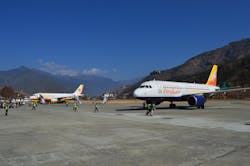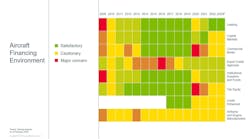There is nothing “ordinary” about Bhutan. Opened to foreign visitors only in 1974, the nation most well known for its measure of “Gross National Happiness” has continued to slowly and cautiously open itself to increased tourism. Though a landlocked nation with mountainous terrain, road access is possible but slow and often “adventurous” as there may be one kilometer of straight level road in the entire country. All goods that most of us take for granted in our daily lives, including fuel, must be trucked in — a particular challenge in the monsoon season when access from India is often impaired.
As such, airplanes would seem to be a natural supply line for such conditions. However, the same mountains that make road travel complex also impede aviation development. The only international airport is located in the Paro Valley, adjacent to a city of the same name and an hour by road from the population center and capital, Thimpu. While the valley is clear enough to allow aviation operations, it comes with restrictions and operating challenges that are unrivaled elsewhere in the world. One only needs to pull up a YouTube video taken on approach or departure to see that both present perilous challenges. For a more static view, check out a photo on Google Earth to get a sense of just how precise the flying must be. In addition, crosswinds limit operations to the morning hours for a good chunk of the year. The field is daylight only and has no approach lights.
Quite a ride
Landings are all on Runway 33 and touchdown comes after zigging and zagging through the valley with a departure on 15 requiring a climbout of equal complexity. Taking off on 15 points the aircraft at a range of mountains that must be avoided by a left turn into a navigable passage as altitude is gained. For aviation buffs the approach and departure process is fascinating — for nervous flyers, not so much.
All of this geography means that the aircraft serving the airport must be specially adapted. Both Bhutanese carriers, Druk Air and Bhutan Air operate A319s with uprated engines which supply the thrust normally found on the larger A320. And despite all this, both airlines most often still operate with reduced payloads and the “first stops” after departure are all within a one-hour flight radius. Flights to Bangkok, a primary feed for both carriers, operate via various points in India and Bangladesh — with the reduced fuel load allowing a larger, but never full, payload. For Druk Air’s A319s with a certified MTOW of 64 tons, the airline’s own limits reduce that to 59.7 tons — on the ideal day.
Most of the fuel used is uploaded at outstations and only top-off fuel is added at Paro. While the fuel is cheaper abroad, there is the weight penalty imposed by tanking fuel into Bhutan, which also adds to the cost of the operation.
Given all of these parameters, aircraft utilization is about five hours per day, a number that most carriers would find economically untenable. But of course, in this case, additional flying is not an option.
A slowly expanding market
Druk Air is a government carrier and has been operating since 1983 with a broad assortment of equipment. The country was only opened to foreign visitors in 1974 when the present king was crowned. There were 20 of them, so for the first few years of the airline’s operations, minimal capacity was required. But the government has slowly and cautiously expanded the number of visas issued and in 2013 some 44,000 tourists visited. The overriding goal of the government is to ensure that the cultural and natural charms that attract visitors are not overwhelmed by those same folks, with that balance being a part of the Gross National Happiness mindset.
Last year, after a long period of start up that began in 2011, a private company, Bhutan Air (B3), started operations to Bangkok via Kolkata and Kathmandu. It is owned by Tashi, Bhutan’s largest conglomerate, which consists of the airline and 41 other enterprises. It operates a daily service to/from Bangkok and the second aircraft does a round-trip to Kathmandu on a schedule that varies from thrice weekly to daily, with plans to extend that service to Delhi in the fall. Since KTM is only 250 miles distant, that aircraft has lots of available flight time — provided it happens before noon.
The one advantage the carriers have is that they will be their only competition as the restrictions and special operations have discouraged any external competition — a situation that will very likely remain the status quo.
One flight: a whole day’s schedule
Bhutan Air’s flight to Bangkok departs Paro daily at 10:45 and arrives in Bangkok at 16:10, after an enroute stop in Kolkata. It then remains overnight, departing BKK at 06.30 and arriving Paro at 09.55. Hence, the maintenance and engineering folk sit not at the airline’s home base in Paro but rather in Bangkok where, with rotations, each aircraft remains for the longest period of time. The B3 aircraft are leased from a Singapore lessor for a period of two years, meaning that the aircraft will be returned far ahead of the need for major overhaul — especially given the low daily usage. A line maintenance engineer travels with the aircraft to cover enroute stops.
As one might expect, Bhutan Air is not presently profitable but the “future routes” shown on their map indicate that the airline intends to grow to equal the size and number of destinations that are presently served by Druk Air. One positive note in a very complex and costly operation is that both airlines have 5th freedom rights that allow for passenger carriage between the points served on the way to Bhutan. However, many of those segments have competing services that proscribe either Bhutanese carrier from charging fares commensurate with their higher costs. Still, every fare collected chips away at the cost base. As might be expected, fares through to Bhutan are fairly steep, a direct result of the high costs and lack of external competition.
In a marketplace where many carriers cite high operating costs or restrictive environments, I think it is safe to say that their gripes pale in comparison to the challenges that are faced by the two airlines of Bhutan. But then again, when you arrive, you are in a place where Gross National Happiness is the operative principle and that is a claim that no one else can make.


